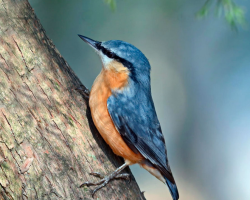With this article, we decided to help all cat lovers. Several master classes on creating a claw-definitely what the lovers of our smaller brothers need.
Content
Spoiled wallpaper, furniture, carpets - all this is a terrible dream of many cats. What to do if you love your pet with all your soul, but you also want to save the apartment in a decent form? Build a claw!
How to make a claw: general recommendations
First of all, you should pay attention to general recommendations for creating a claw:
- It is very important to choose the right height. It is recommended to raise the cat on the hind legs - this will be the minimum height of the unit. You can and even preferably build a claw of a claw, but less is not worth it.
Important: the height of the column in any case should not be lower than 90-100 mm.
- Concerning widths, then it is preferable to observe the next minimum-8-10 cm in section.
- Sustainability - required condition. The animal will certainly be active and lean with the whole body when grinding claws.
- As material for tightening are best suited leg-split with a cross section of about 1 cm, burn. Synthetic ropes are not suitable - The animal can damage the claws. The fabric should not be electric, should be soft.

- Durability - We need to choose such materials that would withstand the pressure of the cat manicure for a long time. For example, perfect dry board, durable plywood, corrugated cardboard of high density.
- As stuffing best suits a synthetic winterizer with a hypoallergenic property.
Important: that when creating a claw, it is worth ignoring is straw, wool, fluff, skin and a substitute for the skin.

How to make a wall claw: a master class
Necessary materials:
- A panel made of wood on which the unit will be attached. Or two panels if a new interior detail is planned by corner
- Brush of wood or panel
- A jute or hemp twine, the threads of which in diameter are at least 5 mm. It is worth stocking up with two slices
- Electrodegol and screws to her
Procedure:
- Electric drill is necessary in the beam and in the panel drill 6 holes. The location is as follows: 2 holes from above, in the center and below.
Important: it is necessary to ensure that the openings of the beam and the openings of the panel are located parallel to each other.
- Then in the holes you need locate screws.
- Now you can start wrapping a bruus with a tourniquet.
- Left flow the beam to the panel.


How to make a claw of corrugated cardboard: Master class
Well -known fact: cats just adore cardboard boxes! So why not use this information strategically? In addition, such a claw is built even faster than the previous option! So, you will need:
Actually, corrugated cardboard. You can replace it even with the most ordinary cardboard boxes
- Paper good density
- A knife that is convenient to cut paper
- PVA-bed or sticky tape
- Any fabric that can decorate the claw
Now it remains to collect the structure:
- On cardboard Drawing strips. The width can be anything, but it should be the same For all blanks
- Now the strips cut
- The so -called core
Important: it is preferable to twist tightly.
- Now stripes are attached to each other, turning around the core
- The frame can be wrapped fabric, chosen for decor
- The workpiece is located on thick paper - from it the bottom is cut future claws
- The last touch - fastening of a cardboard-tone structure on thick paper



How to make a claw-string claw: step-by-step master class
As practice shows, the smaller brothers love this clatter especially. In addition, it is quite compact. So, here's what you need to make it:
- Actually, the pipe itself is at least a meter high
- The foundation is from wood
- Leg-split
- Textile
- Stapler
- Self -tapping screw
- Filler for the pipe - you can choose a wooden block of suitable size or mounting foam
Important: the filler is needed for weighting the structure - it is not recommended to ignore this item.
The procedure for creating a claw:
- Fabric For starters, it is worth it wrap the base. You can attach brackets
- Now you need Decorate the pillar with twine
- Then in the pipe should be lowered A tree bar. Or fill it with foam
- The pipe is attached By the middle of the catwalk with a self -tapping screw
- Can decorate the top columnand hang some toy on a rope to attract cat's attention

Claw-Domik: Master class
A wonderful idea, if you want to please the pet and the claw tete and the house. Would need stock up on the following things:
- Nails
- Hammer
- Hot glue
- Plywood - an approximate size can be 1.7x1.7 m
- Carpet
- Screws and screwdrivers. A screwdriver is preferably choosing an electric one - it works best with screws
- Stapler
- The angles made of steel
- Rope, rope
- A wood timber
Important: the beam must certainly be wide and have the shape of a cylinder.
You can start manufacturing:
- First thing, plywood should be cut into 7 pieces. The approximate size is 0.75x0.5.
- In one of the pieces you need Create a hole - Its diameter depends on the size of the cat.
- With the help of screws and angles you need combine 3 walls of the future house, a wall with a hole and a bottom.
- Carpet acts as upholstery. You can fix it with a stapler. By the way, you can make upholstery and from the inside of the future house.

- Now it is taken the plank-upboard house. She is also covered with carpet.
- Further in the middle of the top is perpendicular to him A beam is placed.
Important: it is better to fasten with nails.
- You can and attach the top to the blank of the house.
- Now the rope must be tightly wrapped around the beam. Here hot glue will come in handy.
- There was another left a piece of plywood -It is placed from above the beam as a shelf-lane. This shelf should also be stuck with carpet, and then to nail it firmly to the beam.
- The final bar - drying a cogue house. It is preferable to allocate a day for this matter.

DIY cat claws: ideas, photo
We offer the attention of readers several ideas, which may inspire the owners of cats:










Grinking claws is not harmfulness, but the need for a must-stand animal. Well, in this case, a direct duty is to help the brother smaller and make small adjustments to the design of the dwelling.







